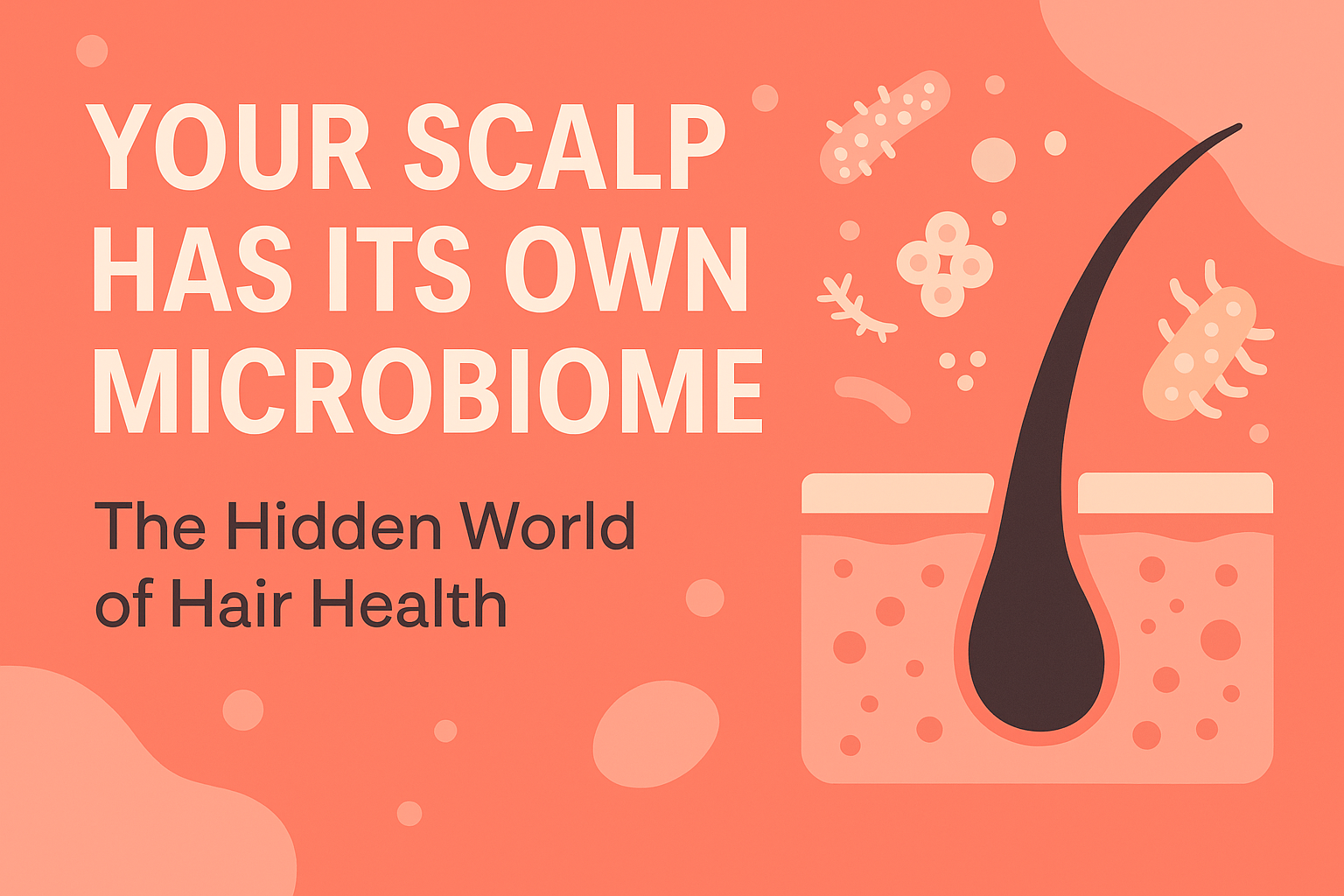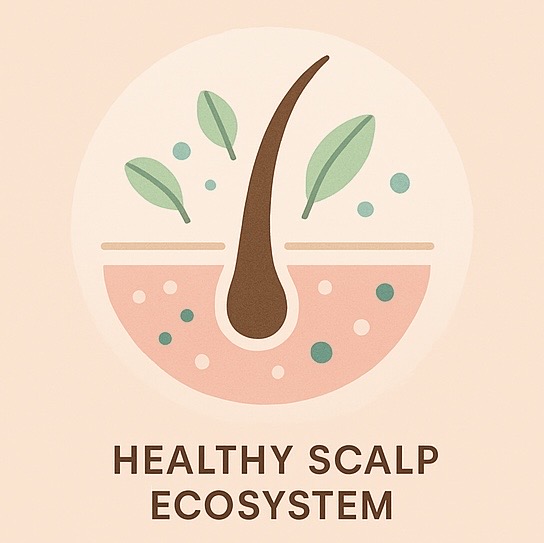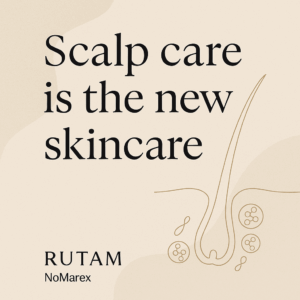
Your Scalp Has Its Own Microbiome (And It’s Probably Unhappy)
Reading Time: 4 minutes | Word Count: 1,100 words
The Invisible Roommates You Never Signed Up For
Here’s something that’ll make you rethink your next shampoo: right now, there are about one billion microorganisms living on every square inch of your scalp. That’s more residents than New York City, and they’re all having very strong opinions about your hair.
Some of these microscopic tenants are absolute angels—working 24/7 to give you gorgeous, healthy hair. Others? Well, they’re basically the worst roommates ever, throwing parties that destroy your hair follicles and leaving behind a mess of inflammation and irritation.
The crazy part? Most people have no idea this bacterial soap opera is playing out on their heads every single day.
Meet Your Scalp’s Invisible Ecosystem

Your scalp isn’t just skin with hair poking through it. It’s a complex biological city with distinct neighborhoods, each home to different communities of bacteria, fungi, and other microorganisms.
The good neighborhoods (where you want to live):
- Populated by Staphylococcus epidermidis—the friendly security guards
- Cutibacterium acnes in reasonable numbers—the maintenance crew
- Lactobacillus strains—the peacekeepers who keep everyone calm
The sketchy areas (where things go wrong):
- Malassezia fungus parties that never end
- Staphylococcus aureus gangs causing trouble
- Various troublemakers that move in when the good guys leave
Plot twist: Harvard research found that people with thick, healthy hair have 300% more diverse bacterial communities than those dealing with hair loss. Coincidence? Absolutely not.
Why Your Hair’s Fate Lies in Bacterial Hands
Think your genetics determine your hair destiny? Think again. Your scalp’s microbiome has way more influence over your hair than you realize.
Here’s what happens when your bacterial balance is on point:
- Your scalp’s pH stays perfectly acidic (around 5.0)—exactly what hair loves
- Beneficial bacteria produce natural antimicrobials that fight off troublemakers
- Inflammation stays low, so blood flows freely to hair follicles
- Your scalp’s protective barriers stay strong and healthy
But when the bacterial balance goes haywire:
- Harmful bacteria trigger inflammatory responses that choke hair follicles
- Your scalp’s pH goes wonky, creating an environment where hair-damaging organisms thrive
- The protective acid mantle breaks down, leaving your scalp vulnerable
- Hair follicles basically throw up their hands and go on strike
Real talk: A recent MIT study found that certain beneficial bacteria actually produce natural DHT blockers. Yes, the same DHT that causes male pattern baldness. Your scalp bacteria might be your best defense against hair loss.
The Great Shampoo Betrayal
Want to hear something that’ll blow your mind? That expensive shampoo you love might be systematically destroying the very bacteria that could give you amazing hair.
Most commercial shampoos are basically bacterial warfare in a bottle:
Sodium Lauryl Sulfate (SLS): Creates that satisfying foam while annihilating your scalp’s protective bacterial layer. It’s like using bleach to clean a garden—effective, but devastating.
Parabens: These preservatives don’t stop working when they hit your scalp. They keep killing bacteria—including the beneficial ones you desperately need.
Synthetic fragrances: Often contain alcohol and chemicals that alter your microbiome composition faster than you can say “tropical coconut breeze.”
The tragic irony: The products promising beautiful hair are often destroying the biological foundation that healthy hair depends on.
Red Flags Your Microbiome Is Crying for Help
Your scalp has a sophisticated way of telling you when its bacterial ecosystem is in trouble. Most people ignore these early warning signs until the damage is already done.
Early SOS signals (catch these and you can turn things around):
- Scalp itching that gets worse after washing
- Hair that feels different—coarser, drier, or strangely greasy
- Products that used to work fine now cause irritation
- Subtle changes in how your scalp smells (not necessarily bad, just different)
The “Houston, we have a problem” stage:
- Persistent dandruff that doesn’t respond to regular shampoo
- Increased hair shedding (more than 100 hairs per day)
- Scalp sensitivity that seems to get worse over time
- Hair growth that seems slower than usual
The “call for backup” emergency phase:
- Noticeable hair thinning or bald patches
- Chronic scalp inflammation or pain
- Hair that breaks easily despite gentle handling
- Complete product intolerance—everything burns or irritates
Your Microbiome Recovery Game Plan

Ready to make peace with your scalp’s bacterial residents? Here’s how to turn your scalp from a war zone into a thriving ecosystem:
Step 1: Stop the massacre Switch to sulfate-free, pH-balanced shampoos. Look for products that say “microbiome-friendly” or “probiotic” on the label.
Step 2: Feed the good guys Add a scalp serum with prebiotics (food for beneficial bacteria) to your routine. Your good bacteria will multiply like crazy when properly fed.
Step 3: Reinforce with probiotics Use products containing live beneficial bacteria or their fermented byproducts. It’s like sending in reinforcements to help the good guys win.
Step 4: Create optimal conditions Keep your scalp’s pH slightly acidic with toners or rinses. Most beneficial bacteria thrive in acidic environments, while troublemakers prefer alkaline conditions.
Step 5: Be patient but consistent Microbiome restoration takes 4-6 weeks minimum. Your scalp didn’t get out of balance overnight, and it won’t recover instantly either.
The Bottom Line
Your scalp is hosting a microscopic city that has more influence over your hair than you ever imagined. The residents of this city—beneficial bacteria, harmful bacteria, and everything in between—are constantly negotiating the terms of your hair’s health.
You can’t see them, but they’re there. You can’t control them completely, but you can definitely influence them. And when you start working with your scalp’s microbiome instead of against it, the results can be pretty incredible.
The revolution starts in your shower: Next time you reach for that foam-producing, synthetic-scented shampoo, remember that you’re not just cleaning your hair. You’re making a choice about which bacteria get to call your scalp home.
Choose wisely. Your hair’s future depends on it.
Coming next: “The Gut-Scalp Connection (Yes, Really)” – Get to know the specific microorganisms that determine your digestive health directly affects your scalp microbiome.
Take action today: Check the ingredient list on your current shampoo. If it contains sodium lauryl sulfate or parabens, it might be time for a microbiome-friendly upgrade.

